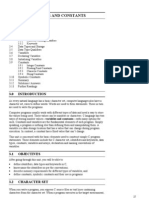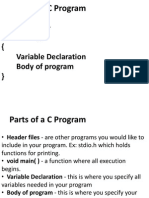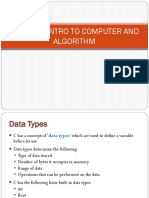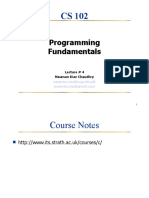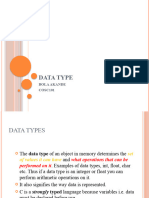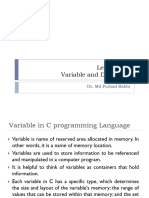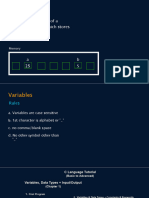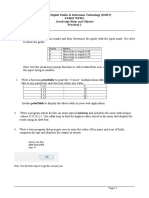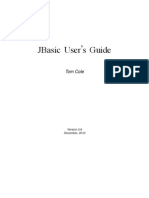Intro to variable
Overview
Variables in C programming are containers for storing data, much like glasses
holding water. They link values to memory locations, allowing dynamic
manipulation of data in a program.
Key Concepts
1. What are Variables?
Variables are placeholders for data, enabling dynamic changes during
program execution.
Example:
int age = 25; // `age` stores the value 25
printf("Age: %d", age);
Practice Question:
Declare a variable to store your name and display it using
printf() .
2. Memory Locations and Variables
Each variable is associated with a specific memory location.
Example: Using the address-of operator ( & ) to print memory location:
int x = 10;
printf("Memory address of x: %p\n", &x);
Practice Question:
Write a program that declares an integer variable and prints its memory
address.
3. Declaration vs. Definition
Intro to variable 1
� Declaration: Tells the compiler the type and name of the variable.
Definition: Allocates memory for the variable.
Example:
extern int x; // Declaration
int x = 10; // Definition
Practice Question:
Declare a float variable using
extern , then define it and assign a value.
4. Initialization
Assigning a value during declaration.
Example:
int y = 20; // Declaration and initialization
Practice Question:
Declare and initialize variables for temperature (float) and year (int) in a
single line.
5. Variables are Changeable
Unlike constants, variables can be reassigned.
Example:
int z = 15;
z = 30; // Value of `z` is updated
printf("Updated value: %d\n", z);
Practice Question:
Write a program where a variable stores a number, doubles it, and prints
the result.
6. Data Types and Memory Allocation
Intro to variable 2
� The type of a variable determines its size and type of data it can store.
Example:
char ch = 'A'; // 1 byte
float pi = 3.14; // 4 bytes
Practice Question:
Create variables of different types (
int , float , char ) and display their sizes using sizeof() .
7. Multiple Declarations in a Single Line
Example:
int a = 1, b = 2, c = 3;
printf("%d %d %d\n", a, b, c);
Practice Question:
Declare three variables in one line, initialize them, and print their sum.
Key Insights
1. Understanding Variables
Variables provide a flexible way to manipulate data in programs, making
them essential for dynamic and responsive applications.
2. Memory Management
When declaring variables, memory is automatically allocated, allowing
programmers to focus on logic rather than memory addresses.
3. Declaration vs. Definition
Declaration specifies the variable, while definition allocates memory. This
distinction is crucial for efficient coding.
4. Dynamic Nature of Variables
The ability to change values enables adaptability in programs, a hallmark
of dynamic systems.
Intro to variable 3
� 5. Data Types and Performance
Choosing appropriate data types ensures optimal memory usage and
program performance.
6. Syntax and Semicolons
Every variable declaration must end with a semicolon ( ; ) to avoid
compilation errors.
7. Streamlining Code with Multiple Declarations
Declaring multiple variables in one line improves readability and reduces
clutter.
Summary
Variables are foundational in C programming, serving as dynamic containers for
data. Understanding their properties, memory linkage, and syntax helps create
efficient, adaptable, and clear programs.
Practice Questions
1. Write a program that declares two integer variables, swaps their values, and
prints the result.
2. Declare a const variable for the value of pi and attempt to change its value.
Observe and explain the compiler's behavior.
3. Create a program that accepts user input for a variable and displays its value
along with its memory address.
4. Declare three float variables on a single line to store the lengths of a triangle’s
sides and calculate its perimeter.
5. Write a program that demonstrates the difference between declaring and
defining a variable.
By practicing these concepts, you can strengthen your understanding of variables
and their role in C programming!
Intro to variable 4
� Naming Variables
Key Rules and Concepts
1. Allowed Characters
Variable names can include letters (A-Z, a-z), digits (0-9), and
underscores ( _ ).
Example:
int age = 25; // Valid
float _height = 5.9; // Valid
Practice Question:
Declare three variables using valid naming conventions and assign values
to them.
2. Restrictions on Starting Characters
Variable names cannot start with a digit or underscore.
Example:
// int 1name = 10; // Invalid
// int _temp; // Avoid starting with underscores
Practice Question:
Identify and correct the errors in the following declarations:
int 9lives, _score; .
3. Case Sensitivity
C is case-sensitive, so variable and Variable are treated as different
identifiers.
Example:
int score = 10;
int Score = 20;
Intro to variable 5
� printf("%d %d", score, Score); // Outputs: 10 20
Practice Question:
Write a program demonstrating the case sensitivity of variable names.
4. Avoid Special Characters
Special characters (except _ ) are not allowed in variable names.
Example:
// int @value = 100; // Invalid
Practice Question:
Rewrite the invalid variable name
@age into a valid one and use it in a program.
5. Reserved Keywords
Keywords like int , float , if cannot be used as variable names.
Example:
// int if = 10; // Invalid
int if_value = 10; // Valid alternative
Practice Question:
List five reserved keywords and suggest valid alternatives for using them
as variable names.
6. Readable Naming
Use underscores to separate words for clarity, e.g., user_name instead of
username .
Example:
int total_score = 95;
printf("Total Score: %d", total_score);
Intro to variable 6
� Practice Question:
Declare variables for
user age , total marks , and is passed using readable naming conventions.
7. Length of Variable Names
Keep names short yet descriptive to reduce errors and improve readability.
Example:
int x = 10; // Too short, unclear purpose
int userAge = 10; // Descriptive and concise
Practice Question:
Rename the variable
abcd to make its purpose clear in a program that calculates a student’s
grade.
8. Avoiding System-Reserved Names
Names starting with an underscore ( _ ) are often system-reserved and
should be avoided.
Example:
// int _myVar = 10; // Avoid if unnecessary
int myVar = 10; // Preferred
Practice Question:
Identify system-reserved names in the given code and suggest
alternatives.
Key Insights
1. Readability and Maintenance
Well-named variables improve code readability, making debugging and
maintenance easier, especially in collaborative projects.
2. Avoiding Errors
Intro to variable 7
� Following naming rules ensures the program compiles and runs smoothly,
avoiding unnecessary errors.
3. Reserved and System Names
Staying clear of keywords and system-reserved names prevents conflicts
and unexpected behavior.
4. Efficient Coding
Short yet descriptive names reduce the chance of typos and make the
code intuitive to read and edit.
5. Case Sensitivity Awareness
Utilizing consistent case conventions for variables (e.g., lowercase for
variables, uppercase for constants) enhances code organization.
Practice Questions
1. Write a program to declare variables for a library system: book count ( int ),
librarian name ( char[] ), and daily fine ( float ). Use proper naming
conventions.
2. Correct the errors in these declarations: int 123name, char* name!, float class; .
3. Write a program to calculate the area of a rectangle using well-named
variables and display the result.
4. Demonstrate the case sensitivity of variables by declaring total , Total , and
TOTAL with different values and printing them.
5. Create a program that uses underscores in variable names to calculate the
sum of two numbers ( first_number and second_number ).
By adhering to these naming conventions and practicing the concepts, you’ll build
efficient, readable, and error-free C programs!
Intro to variable 8


